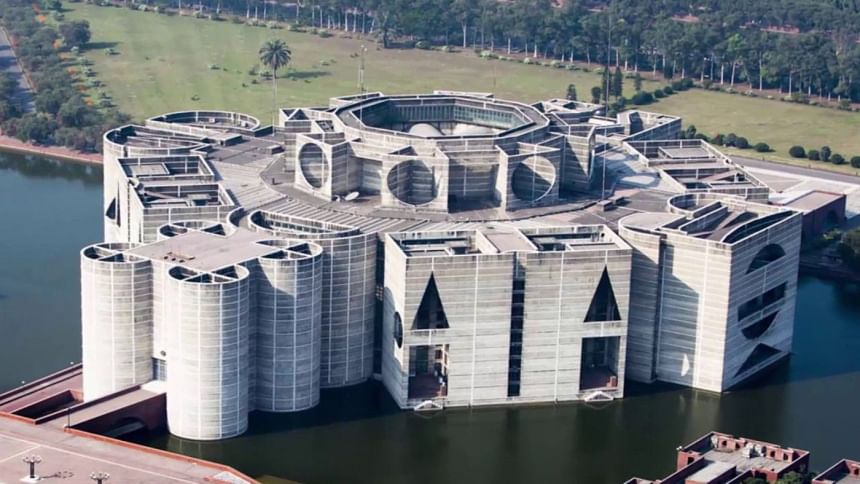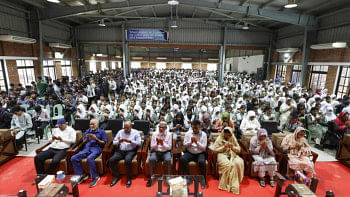Spaces of ambivalence

"Each monumental space becomes the metaphorical and quasi-metaphorical underpinning of a society, this by the virtue of a play of substitutions in which the religious and political realms symbolically (and ceremonially) exchange attributes—the attributes of power." —Henri Lefebvre.
The term "modern" has multiple meanings "relating to the present and recent times, as opposed to the remote past; of, relating to, or originating in the current age or period", which is contrary to being traditional and dependent on orthodox beliefs. Modernity refers to a specific historic time-period; it also refers to a state of being, an experience that is post-agrarian and characterised by capitalism, rationalism, and secularism. It goes hand in hand with secularism, which germinated and evolved through the three centuries of the Renaissance and its wake (14th to 17th century). Modernity evolved further with the paradigm of the Enlightenment (18th century) and accelerated with the Industrial Revolution (early to mid-19th century), and continues to this day. Anything modern becomes synonymous with industrialisation, urbanisation and consequently, progressiveness.
In 1947, there was the bloody birth of two interdependent countries—India and Pakistan —leaving millions homeless, orphaning thousands and putting all in a crisis of identity. Although the division was based on religious majority geographic areas, the hope was of a secular, modern and democratic nation, at least in India. The first prime minister of India, Jawaharlal Nehru, insisted on modern mega-projects that were symbolic interventions in India's then traditional landscape and created, or rather imposed, a new identity onto the people.Nehru invited and later hired two great modernist architects of the 20th century—the French architect Le Corbusier who designed the city of Chandigarh (1960), and the American architect Louis Kahn, who designed the Indian Institute of Management (IIM, 1962-1974) in Ahmedabad. The preference for a foreign architect may seem contrary to the spirit of independence, but the Western style was regarded as the means to remove the national and racial stigma of being "of the East," which at the time was more associated with tradition and suppression. Such modern architectures was supposed to be artifacts of forgetting the immediate past of colonial domination.
Nehru's idea was to adopt modern aesthetics and build urban, industrial and progressive looking cities and campus towns such at IIM and the Indian Institutes of Technology (IITs) to showcase a liberal India. His vision of new Indian cities echoed in his words, "Let this be a new town, symbolic of the freedom of India. Unfettered by the tradition of the past, an expression of the nation's faith in the future." The IITs, designed by various other modernist architects, were meant to become spaces of anti-memory, obliterating the past and becoming "temples of modernity." The hope was that they would be healing agents. As foreseen, the IITs and IIM campuses have become symbols of modernity over the new Indian nationalist landscape.
Bangladesh (then East Pakistan) and West Pakistan were no further behind. In June 1959, with an approaching election, the central government of Pakistan under General Ayub Khan decided to create two new capitals, one in Dhaka, and the other in Islamabad. The South Asian nations were certainly in competition with each other, prompting Ayub Khan to rely on Bengali, modernist guru and pioneer architect Muzhrarul Islam's decision to bring in a big name, equal in stature to Le Corbusier.
Designed by Louis Kahn, an icon in the modern architectural world, the National Assembly Complex in Dhaka (more commonly known as the Jatiya Sangsad Bhaban)—the work on which was halted during the Liberation War—was later intended to stand as an emblem of Bangladesh's democratic struggles and triumph. Kahn's design bestowed us with a monument that holds a unique place in the country's national imagination. The Sangsad Bhaban created a national identity for the country, as is evident from the Bangladeshi currency notes, which hold its image along with that of other heritage sites.
To make these cities and their architecture look secular, both Corbusier and Kahn consciously adopted stylistic modern aesthetics: architecture without minarets, domes or other direct symbolic elements. In fact, Kahn faced friction with the Government of Pakistan for avoiding any forms that may seem Islamic. These designs, without objectifying any race, religion or creed, exemplified secular and neutral architectural aesthetics and were in the same vein with other world architecture of that period.
However, after almost three-quarter of a century of partition, South Asia still suffers from an acute schizophrenia. It has a modern, nationalist landscape, yet our socio-cultural structures are yet to be modern. Informality—unlike the formalism of modernity—is its vein, and our societies seem unable to accept modern value systems. With social backwardness, rising religious orthodoxy and an ongoing practice of volatile, religion-centered politics in the South Asian countries, can we truly call ourselves modern? Have the visions of Jawaharlal Nehru, Bankimchandra Chattopadhyay, Huseyn Shaheed Suhrawardy, Maulana Bhashani, Mahatma Gandhi and many others—who expanded on the co-existence of religion and progression, modernism and traditionalism, the rational and the irrational, and the perceived ideas of the East and the West—failed?
The freedom we achieved in 1947 was neither the resolution of a problem, nor the beginning of the South Asian liberal society. Rather, it was the beginning of an ambiguous identity. Riots, clashes over inequalities and rising tensions, not only among different religious groups but also between unequal social classes, define a discontent modern South Asia. Therefore, with persisting dichotomies amid the strong pluralistic culture of the subcontinent, Kahn's and Corbusier's modern capitals and institutions remain as "spaces of ambivalence" and not of the modernity they once aspired to.
Conceivably, these edifices and cities were prematurely envisioned and consequently produced along the lines of deliberate historical and social ruptures. While they signify modernity, we still suffer from the deep-rooted ideological backwardness that continues from the region's pre-modern and pre-independence paradigm. Hence, it is a visible, as well as an invisible, rift between people and the designed spaces. This separation is not solely mental; with more recently implemented barriers, walls and heightened security, these places of modernist hopes have instead become physical isolated from the public. Yet these modernist enclaves are now a quintessential part of the everyday nationalistic landscape that represent South Asia's modernity, from which we cannot divorce ourselves.
We cannot claim this to be the failure of the architecture per se; after all, spatial meaning relies on the people's use and imagination, as well as both personal and collective memories. While Kahn and Corbusier have perished, their designed places have become a simultaneity of past, present and future; of the past that is an attempt at erasure, the present that is the failure and the future, which is our hope. We can also see these spaces as a representation of progress towards democracy.
With concrete and bricks, these are the sites of permanence in conjunction with the temporality of history, society and memory. According to urban and postmodern political geographer, Edward J Soja, they are the "third space", with the combination and simultaneities of "the real and the imagined." Perhaps we could also add "permanence and temporary" in the paradigm of South Asian modernity, representing a society that is in constant flux and where modern ideals can still be elusive. Therefore, the façades of these edifices and the society of real citizens are two worlds that are constantly asserting their claims (or images). Can these spaces become the antidote to alleviate modernity's discontent in South Asia? Can we ever evolve into becoming modern and reclaim these spaces as our own?
Nubras Samayeen is a doctoral scholar of architecture, landscape and heritage at the University of Illinois,
Urbana-Champaign.

 For all latest news, follow The Daily Star's Google News channel.
For all latest news, follow The Daily Star's Google News channel. 



Comments